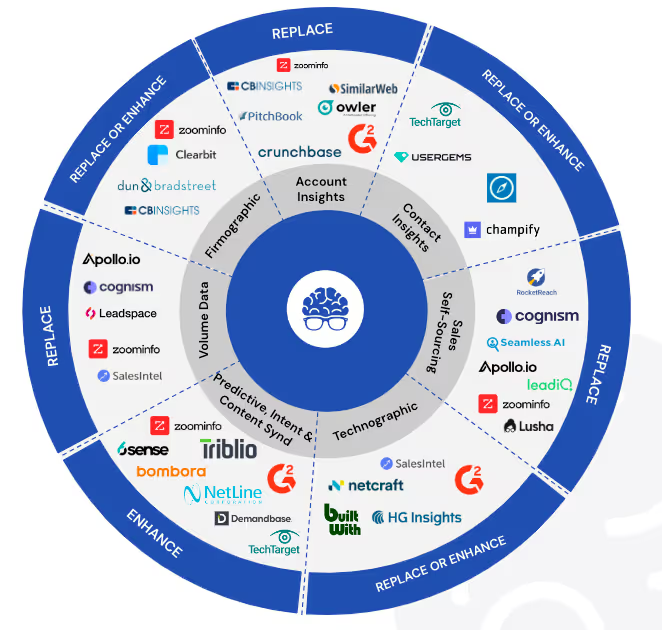Evaluating data vendors is a critical step in ensuring your organization partners with the best provider for your specific needs. Here’s a detailed, step-by-step process to help you thoroughly evaluate data vendors:
1. Define Your Requirements
- Identify Your Needs: Determine the type of data you require (e.g., firmographics, technographics, account signals, social insights).
- Specify Use Cases: Understand how this data will be used within your organization, whether for marketing, sales, or strategic planning.
- Set Data Quality Standards: Establish criteria for data quality, including accuracy, completeness, timeliness, and relevance.
2. Pull Benchmarks and Establish KPIs for Success and Uplift
- Current Performance Analysis: Review your current data usage and performance to set a baseline.
- Define KPIs: Identify key performance indicators (KPIs) that will measure the success of the data vendor, such as lead conversion rates, data accuracy improvement, and campaign effectiveness.
- Set Uplift Goals: Determine the expected uplift or improvement from using the new data vendor, such as a 10% increase in lead quality.
3. Establish Your Budget and Expected ROI
- Budget Planning: Define the budget available for data procurement and integration.
- ROI Calculation: Estimate the return on investment (ROI) by considering the potential increase in revenue, cost savings, and other benefits from improved data.
4. Use Your Network and Sites like G2 or ChatGPT to Establish a List of Possible Vendors
- Leverage Networks: Seek recommendations from peers, industry groups, and professional networks.
- Research Online Reviews: Use platforms like G2, Trustpilot, and Gartner Peer Insights to read reviews and ratings of data vendors.
- Consult ChatGPT: Use AI tools to gather additional information and insights about potential vendors.
5. Meet with Vendors
- Initial Contact: Reach out to shortlisted vendors to schedule meetings and demonstrations.
- Prepare Questions: Have a list of questions ready to evaluate their offerings, support, and integration capabilities.
- Evaluate Responsiveness: Assess how responsive and knowledgeable the vendors are during initial interactions.
6. Narrow Your Options Based on Fit
- Alignment with Requirements: Eliminate vendors that do not meet your defined requirements or fail to impress during initial meetings.
- Evaluate Flexibility: Consider how flexible the vendor is in customizing their offerings to meet your specific needs.
- Reference Checks: Ask for and contact references to get real-world feedback on the vendor’s performance.
7. Deep Dive into a Sample and/or Demo
- Request Samples: Obtain sample data sets to evaluate quality and relevance.
- Demo Sessions: Schedule detailed demonstrations to see the platform in action.
- Pilot Projects: Consider running a pilot project to test the vendor’s data in a live environment.
8. Run Bakeoff with Your Standard Playbook
- Standard Playbook: Develop a standard playbook to evaluate vendors on a level playing field.
- Execute Tests: Run the same tests or campaigns with each vendor’s data to compare outcomes.
- Crunch the Numbers: Analyze the results from an outcomes and uplift perspective to determine which vendor provides the best value and performance.
9. Negotiate
- Discuss Terms: Negotiate pricing, contract terms, and service-level agreements (SLAs).
- Seek Value-Adds: Ask about additional services or features that can be included at no extra cost.
- Legal Review: Have your legal team review the contract for any potential risks or issues.
10. Select and Sign
- Final Decision: Choose the vendor that best meets your needs, budget, and has demonstrated a clear ROI potential.
- Contract Signing: Finalize and sign the contract, ensuring all agreed-upon terms are included.
- Onboarding Plan: Develop an onboarding plan to integrate the new data vendor’s offerings into your workflows smoothly.
By following these steps, you can systematically evaluate and select a data vendor that aligns with your organizational goals and maximizes the value of your data initiatives.




